PR in Entertainment: A Wider View of Culture in Public Relations
VerifiedAdded on 2023/06/15
|10
|2907
|222
AI Summary
This article explores the impact of culture on public relations in the entertainment industry, with a focus on Hollywood and the portrayal of PR practitioners in films. It also discusses the role of media relations in shaping culture and beliefs.
Contribute Materials
Your contribution can guide someone’s learning journey. Share your
documents today.
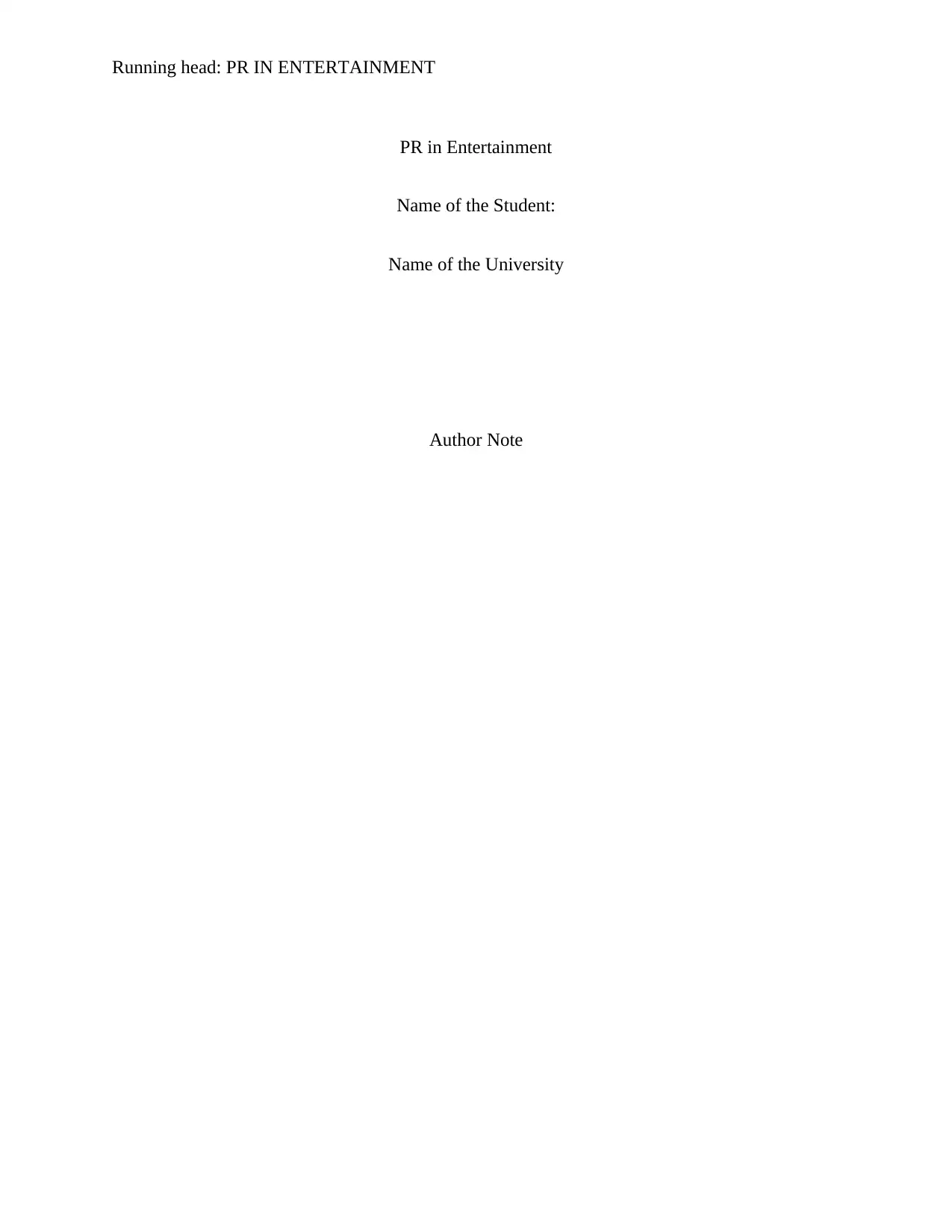
Running head: PR IN ENTERTAINMENT
PR in Entertainment
Name of the Student:
Name of the University
Author Note
PR in Entertainment
Name of the Student:
Name of the University
Author Note
Secure Best Marks with AI Grader
Need help grading? Try our AI Grader for instant feedback on your assignments.
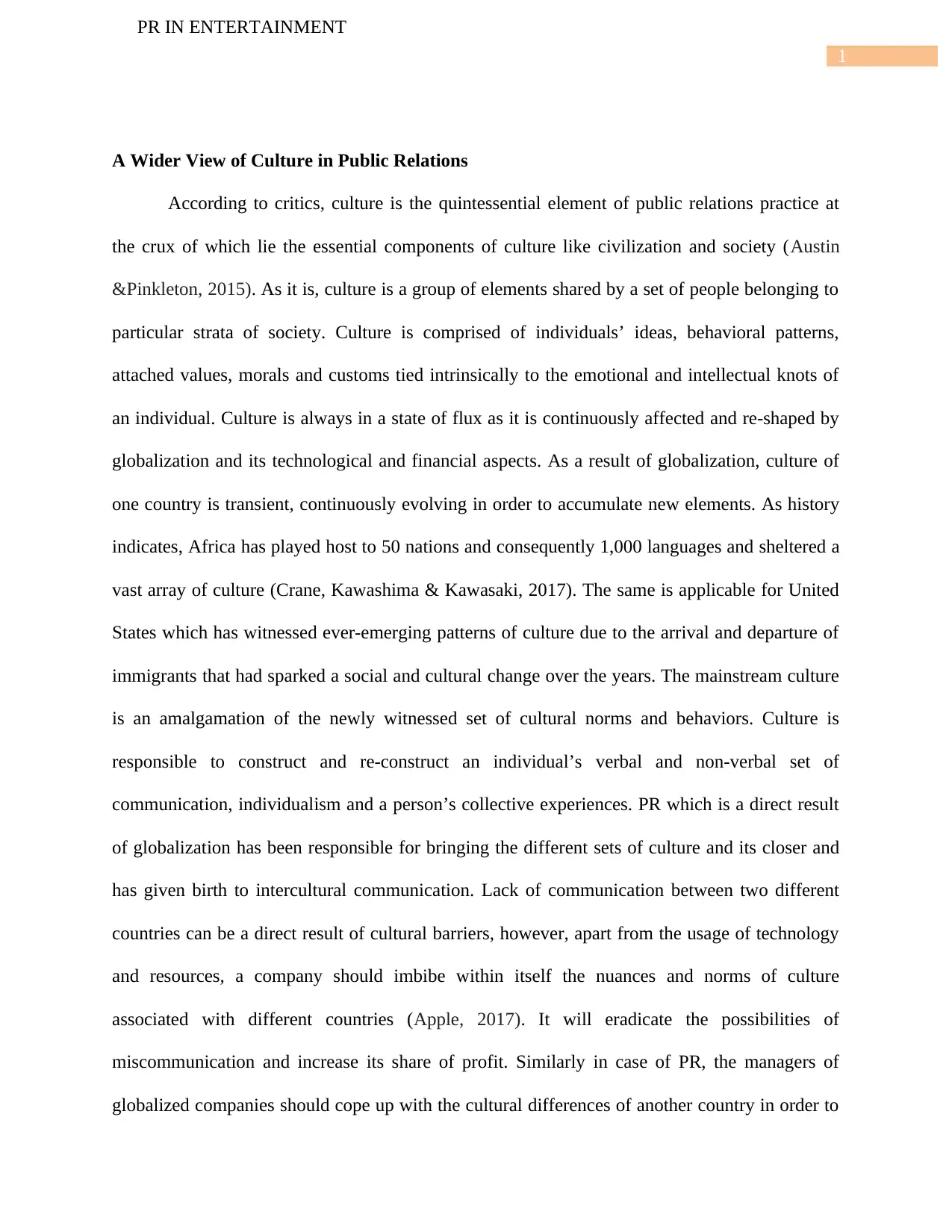
1
PR IN ENTERTAINMENT
A Wider View of Culture in Public Relations
According to critics, culture is the quintessential element of public relations practice at
the crux of which lie the essential components of culture like civilization and society (Austin
&Pinkleton, 2015). As it is, culture is a group of elements shared by a set of people belonging to
particular strata of society. Culture is comprised of individuals’ ideas, behavioral patterns,
attached values, morals and customs tied intrinsically to the emotional and intellectual knots of
an individual. Culture is always in a state of flux as it is continuously affected and re-shaped by
globalization and its technological and financial aspects. As a result of globalization, culture of
one country is transient, continuously evolving in order to accumulate new elements. As history
indicates, Africa has played host to 50 nations and consequently 1,000 languages and sheltered a
vast array of culture (Crane, Kawashima & Kawasaki, 2017). The same is applicable for United
States which has witnessed ever-emerging patterns of culture due to the arrival and departure of
immigrants that had sparked a social and cultural change over the years. The mainstream culture
is an amalgamation of the newly witnessed set of cultural norms and behaviors. Culture is
responsible to construct and re-construct an individual’s verbal and non-verbal set of
communication, individualism and a person’s collective experiences. PR which is a direct result
of globalization has been responsible for bringing the different sets of culture and its closer and
has given birth to intercultural communication. Lack of communication between two different
countries can be a direct result of cultural barriers, however, apart from the usage of technology
and resources, a company should imbibe within itself the nuances and norms of culture
associated with different countries (Apple, 2017). It will eradicate the possibilities of
miscommunication and increase its share of profit. Similarly in case of PR, the managers of
globalized companies should cope up with the cultural differences of another country in order to
PR IN ENTERTAINMENT
A Wider View of Culture in Public Relations
According to critics, culture is the quintessential element of public relations practice at
the crux of which lie the essential components of culture like civilization and society (Austin
&Pinkleton, 2015). As it is, culture is a group of elements shared by a set of people belonging to
particular strata of society. Culture is comprised of individuals’ ideas, behavioral patterns,
attached values, morals and customs tied intrinsically to the emotional and intellectual knots of
an individual. Culture is always in a state of flux as it is continuously affected and re-shaped by
globalization and its technological and financial aspects. As a result of globalization, culture of
one country is transient, continuously evolving in order to accumulate new elements. As history
indicates, Africa has played host to 50 nations and consequently 1,000 languages and sheltered a
vast array of culture (Crane, Kawashima & Kawasaki, 2017). The same is applicable for United
States which has witnessed ever-emerging patterns of culture due to the arrival and departure of
immigrants that had sparked a social and cultural change over the years. The mainstream culture
is an amalgamation of the newly witnessed set of cultural norms and behaviors. Culture is
responsible to construct and re-construct an individual’s verbal and non-verbal set of
communication, individualism and a person’s collective experiences. PR which is a direct result
of globalization has been responsible for bringing the different sets of culture and its closer and
has given birth to intercultural communication. Lack of communication between two different
countries can be a direct result of cultural barriers, however, apart from the usage of technology
and resources, a company should imbibe within itself the nuances and norms of culture
associated with different countries (Apple, 2017). It will eradicate the possibilities of
miscommunication and increase its share of profit. Similarly in case of PR, the managers of
globalized companies should cope up with the cultural differences of another country in order to
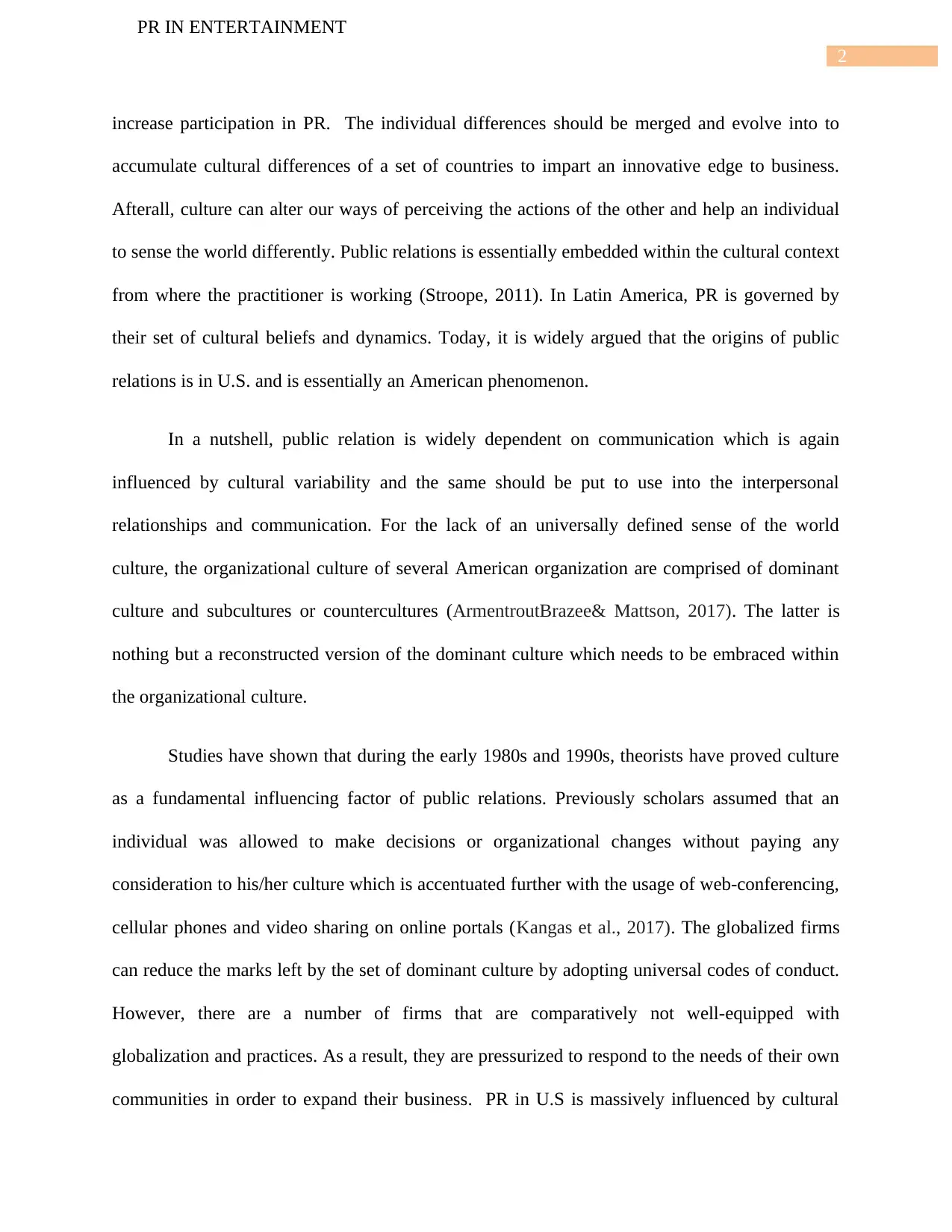
2
PR IN ENTERTAINMENT
increase participation in PR. The individual differences should be merged and evolve into to
accumulate cultural differences of a set of countries to impart an innovative edge to business.
Afterall, culture can alter our ways of perceiving the actions of the other and help an individual
to sense the world differently. Public relations is essentially embedded within the cultural context
from where the practitioner is working (Stroope, 2011). In Latin America, PR is governed by
their set of cultural beliefs and dynamics. Today, it is widely argued that the origins of public
relations is in U.S. and is essentially an American phenomenon.
In a nutshell, public relation is widely dependent on communication which is again
influenced by cultural variability and the same should be put to use into the interpersonal
relationships and communication. For the lack of an universally defined sense of the world
culture, the organizational culture of several American organization are comprised of dominant
culture and subcultures or countercultures (ArmentroutBrazee& Mattson, 2017). The latter is
nothing but a reconstructed version of the dominant culture which needs to be embraced within
the organizational culture.
Studies have shown that during the early 1980s and 1990s, theorists have proved culture
as a fundamental influencing factor of public relations. Previously scholars assumed that an
individual was allowed to make decisions or organizational changes without paying any
consideration to his/her culture which is accentuated further with the usage of web-conferencing,
cellular phones and video sharing on online portals (Kangas et al., 2017). The globalized firms
can reduce the marks left by the set of dominant culture by adopting universal codes of conduct.
However, there are a number of firms that are comparatively not well-equipped with
globalization and practices. As a result, they are pressurized to respond to the needs of their own
communities in order to expand their business. PR in U.S is massively influenced by cultural
PR IN ENTERTAINMENT
increase participation in PR. The individual differences should be merged and evolve into to
accumulate cultural differences of a set of countries to impart an innovative edge to business.
Afterall, culture can alter our ways of perceiving the actions of the other and help an individual
to sense the world differently. Public relations is essentially embedded within the cultural context
from where the practitioner is working (Stroope, 2011). In Latin America, PR is governed by
their set of cultural beliefs and dynamics. Today, it is widely argued that the origins of public
relations is in U.S. and is essentially an American phenomenon.
In a nutshell, public relation is widely dependent on communication which is again
influenced by cultural variability and the same should be put to use into the interpersonal
relationships and communication. For the lack of an universally defined sense of the world
culture, the organizational culture of several American organization are comprised of dominant
culture and subcultures or countercultures (ArmentroutBrazee& Mattson, 2017). The latter is
nothing but a reconstructed version of the dominant culture which needs to be embraced within
the organizational culture.
Studies have shown that during the early 1980s and 1990s, theorists have proved culture
as a fundamental influencing factor of public relations. Previously scholars assumed that an
individual was allowed to make decisions or organizational changes without paying any
consideration to his/her culture which is accentuated further with the usage of web-conferencing,
cellular phones and video sharing on online portals (Kangas et al., 2017). The globalized firms
can reduce the marks left by the set of dominant culture by adopting universal codes of conduct.
However, there are a number of firms that are comparatively not well-equipped with
globalization and practices. As a result, they are pressurized to respond to the needs of their own
communities in order to expand their business. PR in U.S is massively influenced by cultural
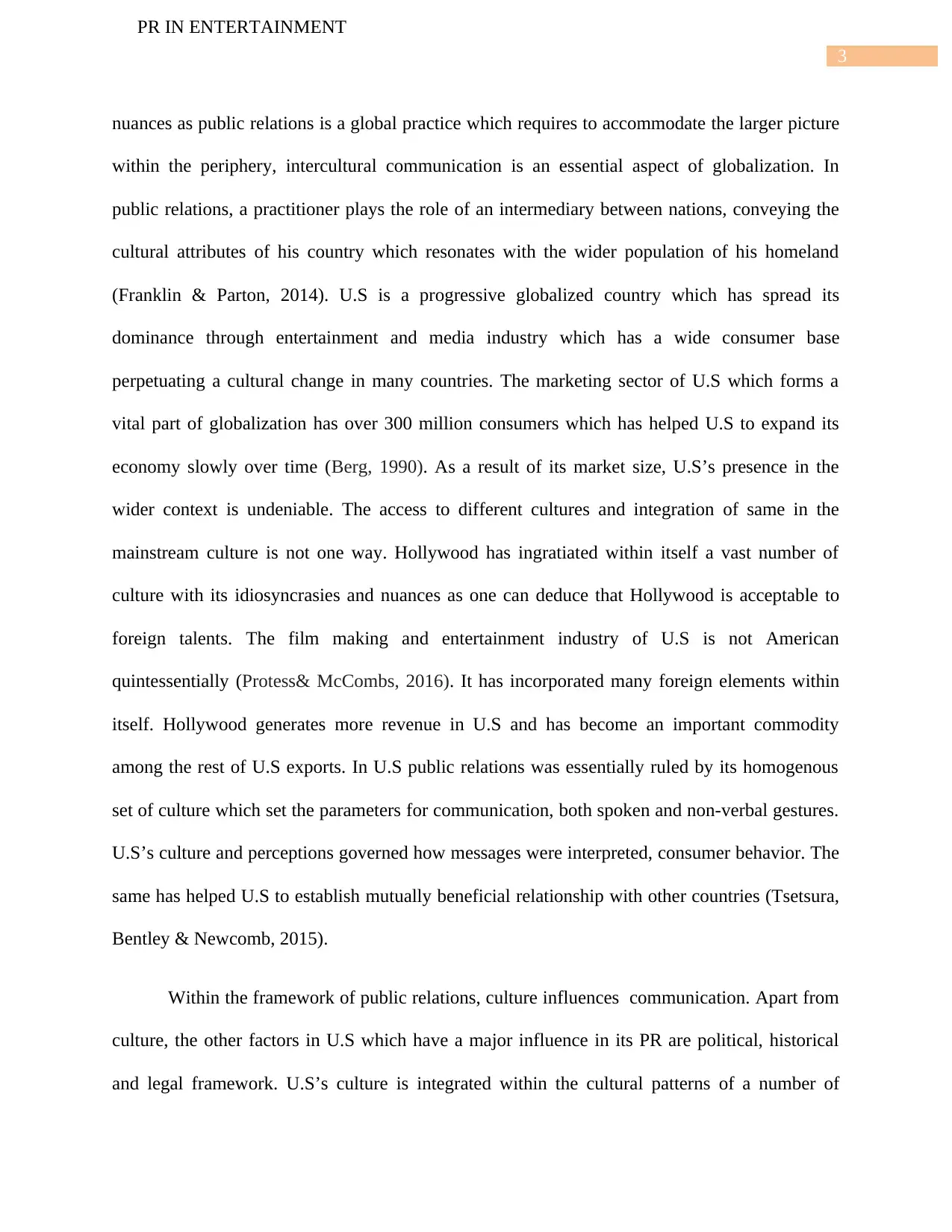
3
PR IN ENTERTAINMENT
nuances as public relations is a global practice which requires to accommodate the larger picture
within the periphery, intercultural communication is an essential aspect of globalization. In
public relations, a practitioner plays the role of an intermediary between nations, conveying the
cultural attributes of his country which resonates with the wider population of his homeland
(Franklin & Parton, 2014). U.S is a progressive globalized country which has spread its
dominance through entertainment and media industry which has a wide consumer base
perpetuating a cultural change in many countries. The marketing sector of U.S which forms a
vital part of globalization has over 300 million consumers which has helped U.S to expand its
economy slowly over time (Berg, 1990). As a result of its market size, U.S’s presence in the
wider context is undeniable. The access to different cultures and integration of same in the
mainstream culture is not one way. Hollywood has ingratiated within itself a vast number of
culture with its idiosyncrasies and nuances as one can deduce that Hollywood is acceptable to
foreign talents. The film making and entertainment industry of U.S is not American
quintessentially (Protess& McCombs, 2016). It has incorporated many foreign elements within
itself. Hollywood generates more revenue in U.S and has become an important commodity
among the rest of U.S exports. In U.S public relations was essentially ruled by its homogenous
set of culture which set the parameters for communication, both spoken and non-verbal gestures.
U.S’s culture and perceptions governed how messages were interpreted, consumer behavior. The
same has helped U.S to establish mutually beneficial relationship with other countries (Tsetsura,
Bentley & Newcomb, 2015).
Within the framework of public relations, culture influences communication. Apart from
culture, the other factors in U.S which have a major influence in its PR are political, historical
and legal framework. U.S’s culture is integrated within the cultural patterns of a number of
PR IN ENTERTAINMENT
nuances as public relations is a global practice which requires to accommodate the larger picture
within the periphery, intercultural communication is an essential aspect of globalization. In
public relations, a practitioner plays the role of an intermediary between nations, conveying the
cultural attributes of his country which resonates with the wider population of his homeland
(Franklin & Parton, 2014). U.S is a progressive globalized country which has spread its
dominance through entertainment and media industry which has a wide consumer base
perpetuating a cultural change in many countries. The marketing sector of U.S which forms a
vital part of globalization has over 300 million consumers which has helped U.S to expand its
economy slowly over time (Berg, 1990). As a result of its market size, U.S’s presence in the
wider context is undeniable. The access to different cultures and integration of same in the
mainstream culture is not one way. Hollywood has ingratiated within itself a vast number of
culture with its idiosyncrasies and nuances as one can deduce that Hollywood is acceptable to
foreign talents. The film making and entertainment industry of U.S is not American
quintessentially (Protess& McCombs, 2016). It has incorporated many foreign elements within
itself. Hollywood generates more revenue in U.S and has become an important commodity
among the rest of U.S exports. In U.S public relations was essentially ruled by its homogenous
set of culture which set the parameters for communication, both spoken and non-verbal gestures.
U.S’s culture and perceptions governed how messages were interpreted, consumer behavior. The
same has helped U.S to establish mutually beneficial relationship with other countries (Tsetsura,
Bentley & Newcomb, 2015).
Within the framework of public relations, culture influences communication. Apart from
culture, the other factors in U.S which have a major influence in its PR are political, historical
and legal framework. U.S’s culture is integrated within the cultural patterns of a number of
Paraphrase This Document
Need a fresh take? Get an instant paraphrase of this document with our AI Paraphraser
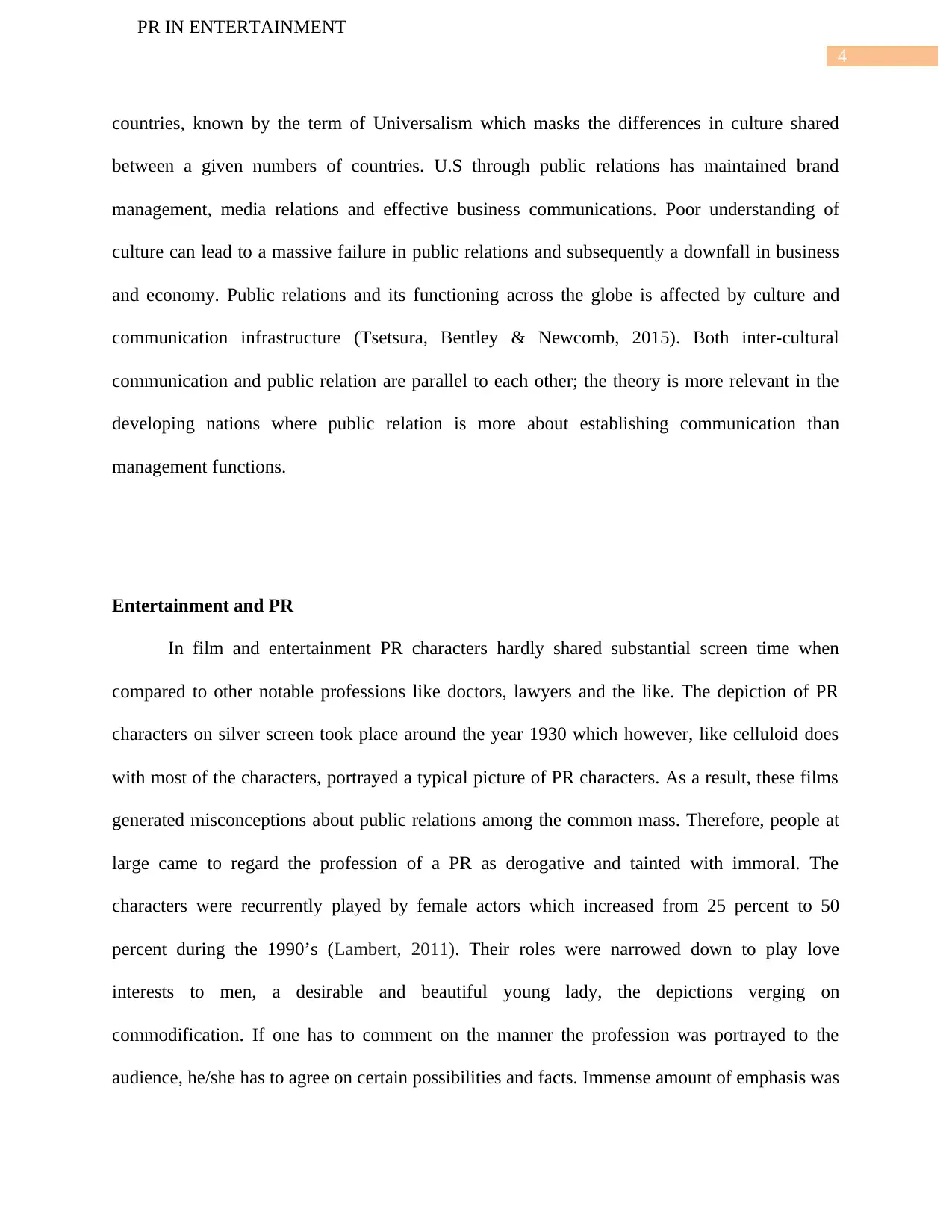
4
PR IN ENTERTAINMENT
countries, known by the term of Universalism which masks the differences in culture shared
between a given numbers of countries. U.S through public relations has maintained brand
management, media relations and effective business communications. Poor understanding of
culture can lead to a massive failure in public relations and subsequently a downfall in business
and economy. Public relations and its functioning across the globe is affected by culture and
communication infrastructure (Tsetsura, Bentley & Newcomb, 2015). Both inter-cultural
communication and public relation are parallel to each other; the theory is more relevant in the
developing nations where public relation is more about establishing communication than
management functions.
Entertainment and PR
In film and entertainment PR characters hardly shared substantial screen time when
compared to other notable professions like doctors, lawyers and the like. The depiction of PR
characters on silver screen took place around the year 1930 which however, like celluloid does
with most of the characters, portrayed a typical picture of PR characters. As a result, these films
generated misconceptions about public relations among the common mass. Therefore, people at
large came to regard the profession of a PR as derogative and tainted with immoral. The
characters were recurrently played by female actors which increased from 25 percent to 50
percent during the 1990’s (Lambert, 2011). Their roles were narrowed down to play love
interests to men, a desirable and beautiful young lady, the depictions verging on
commodification. If one has to comment on the manner the profession was portrayed to the
audience, he/she has to agree on certain possibilities and facts. Immense amount of emphasis was
PR IN ENTERTAINMENT
countries, known by the term of Universalism which masks the differences in culture shared
between a given numbers of countries. U.S through public relations has maintained brand
management, media relations and effective business communications. Poor understanding of
culture can lead to a massive failure in public relations and subsequently a downfall in business
and economy. Public relations and its functioning across the globe is affected by culture and
communication infrastructure (Tsetsura, Bentley & Newcomb, 2015). Both inter-cultural
communication and public relation are parallel to each other; the theory is more relevant in the
developing nations where public relation is more about establishing communication than
management functions.
Entertainment and PR
In film and entertainment PR characters hardly shared substantial screen time when
compared to other notable professions like doctors, lawyers and the like. The depiction of PR
characters on silver screen took place around the year 1930 which however, like celluloid does
with most of the characters, portrayed a typical picture of PR characters. As a result, these films
generated misconceptions about public relations among the common mass. Therefore, people at
large came to regard the profession of a PR as derogative and tainted with immoral. The
characters were recurrently played by female actors which increased from 25 percent to 50
percent during the 1990’s (Lambert, 2011). Their roles were narrowed down to play love
interests to men, a desirable and beautiful young lady, the depictions verging on
commodification. If one has to comment on the manner the profession was portrayed to the
audience, he/she has to agree on certain possibilities and facts. Immense amount of emphasis was
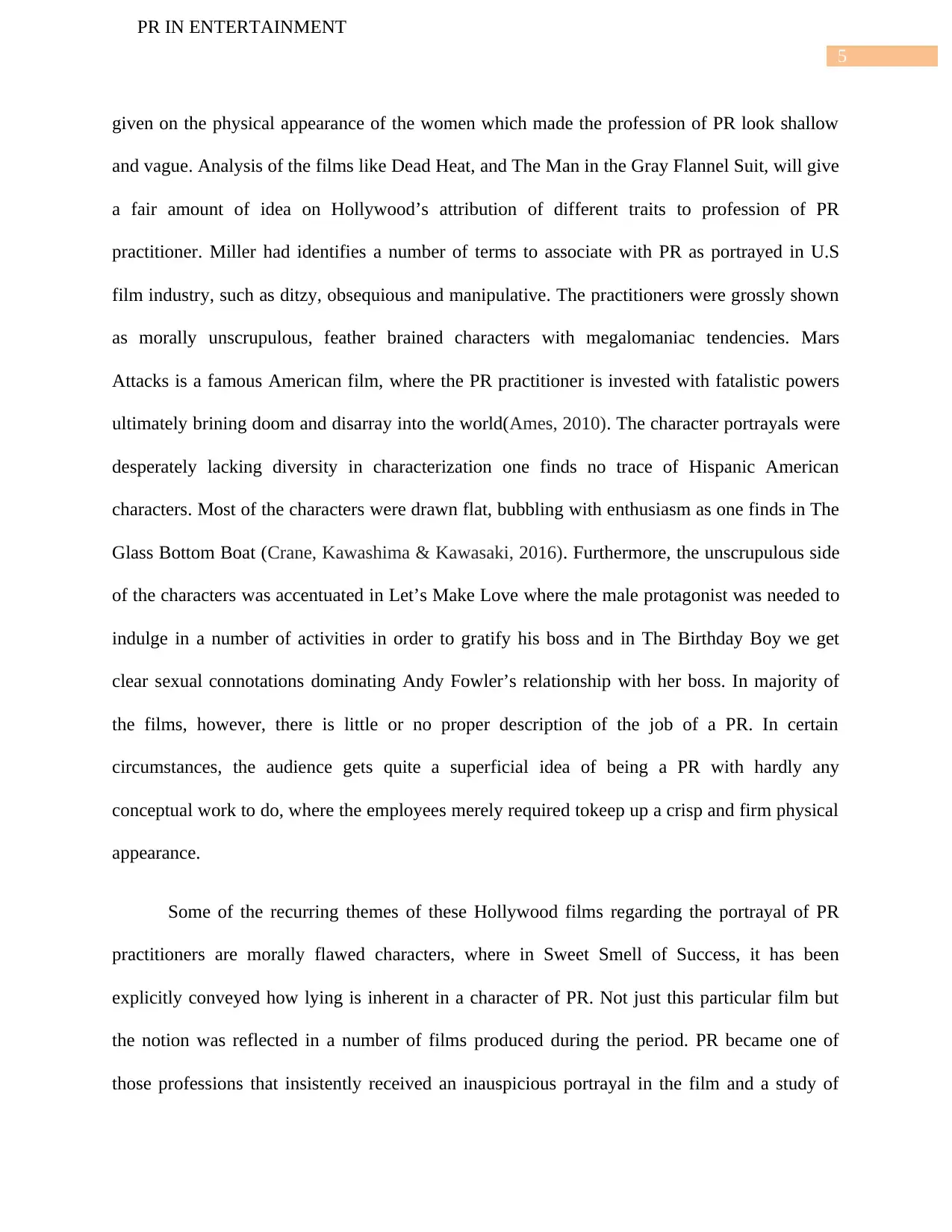
5
PR IN ENTERTAINMENT
given on the physical appearance of the women which made the profession of PR look shallow
and vague. Analysis of the films like Dead Heat, and The Man in the Gray Flannel Suit, will give
a fair amount of idea on Hollywood’s attribution of different traits to profession of PR
practitioner. Miller had identifies a number of terms to associate with PR as portrayed in U.S
film industry, such as ditzy, obsequious and manipulative. The practitioners were grossly shown
as morally unscrupulous, feather brained characters with megalomaniac tendencies. Mars
Attacks is a famous American film, where the PR practitioner is invested with fatalistic powers
ultimately brining doom and disarray into the world(Ames, 2010). The character portrayals were
desperately lacking diversity in characterization one finds no trace of Hispanic American
characters. Most of the characters were drawn flat, bubbling with enthusiasm as one finds in The
Glass Bottom Boat (Crane, Kawashima & Kawasaki, 2016). Furthermore, the unscrupulous side
of the characters was accentuated in Let’s Make Love where the male protagonist was needed to
indulge in a number of activities in order to gratify his boss and in The Birthday Boy we get
clear sexual connotations dominating Andy Fowler’s relationship with her boss. In majority of
the films, however, there is little or no proper description of the job of a PR. In certain
circumstances, the audience gets quite a superficial idea of being a PR with hardly any
conceptual work to do, where the employees merely required tokeep up a crisp and firm physical
appearance.
Some of the recurring themes of these Hollywood films regarding the portrayal of PR
practitioners are morally flawed characters, where in Sweet Smell of Success, it has been
explicitly conveyed how lying is inherent in a character of PR. Not just this particular film but
the notion was reflected in a number of films produced during the period. PR became one of
those professions that insistently received an inauspicious portrayal in the film and a study of
PR IN ENTERTAINMENT
given on the physical appearance of the women which made the profession of PR look shallow
and vague. Analysis of the films like Dead Heat, and The Man in the Gray Flannel Suit, will give
a fair amount of idea on Hollywood’s attribution of different traits to profession of PR
practitioner. Miller had identifies a number of terms to associate with PR as portrayed in U.S
film industry, such as ditzy, obsequious and manipulative. The practitioners were grossly shown
as morally unscrupulous, feather brained characters with megalomaniac tendencies. Mars
Attacks is a famous American film, where the PR practitioner is invested with fatalistic powers
ultimately brining doom and disarray into the world(Ames, 2010). The character portrayals were
desperately lacking diversity in characterization one finds no trace of Hispanic American
characters. Most of the characters were drawn flat, bubbling with enthusiasm as one finds in The
Glass Bottom Boat (Crane, Kawashima & Kawasaki, 2016). Furthermore, the unscrupulous side
of the characters was accentuated in Let’s Make Love where the male protagonist was needed to
indulge in a number of activities in order to gratify his boss and in The Birthday Boy we get
clear sexual connotations dominating Andy Fowler’s relationship with her boss. In majority of
the films, however, there is little or no proper description of the job of a PR. In certain
circumstances, the audience gets quite a superficial idea of being a PR with hardly any
conceptual work to do, where the employees merely required tokeep up a crisp and firm physical
appearance.
Some of the recurring themes of these Hollywood films regarding the portrayal of PR
practitioners are morally flawed characters, where in Sweet Smell of Success, it has been
explicitly conveyed how lying is inherent in a character of PR. Not just this particular film but
the notion was reflected in a number of films produced during the period. PR became one of
those professions that insistently received an inauspicious portrayal in the film and a study of
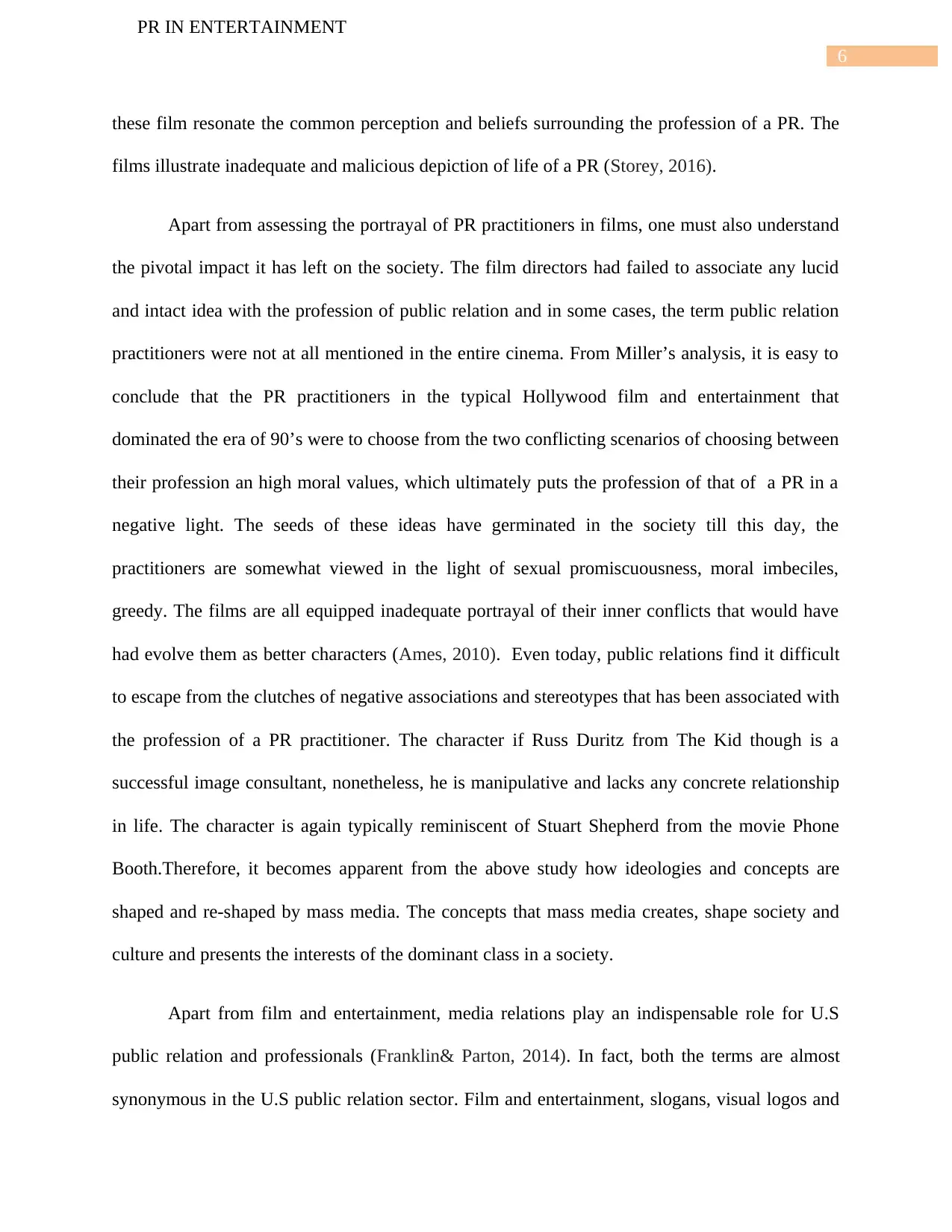
6
PR IN ENTERTAINMENT
these film resonate the common perception and beliefs surrounding the profession of a PR. The
films illustrate inadequate and malicious depiction of life of a PR (Storey, 2016).
Apart from assessing the portrayal of PR practitioners in films, one must also understand
the pivotal impact it has left on the society. The film directors had failed to associate any lucid
and intact idea with the profession of public relation and in some cases, the term public relation
practitioners were not at all mentioned in the entire cinema. From Miller’s analysis, it is easy to
conclude that the PR practitioners in the typical Hollywood film and entertainment that
dominated the era of 90’s were to choose from the two conflicting scenarios of choosing between
their profession an high moral values, which ultimately puts the profession of that of a PR in a
negative light. The seeds of these ideas have germinated in the society till this day, the
practitioners are somewhat viewed in the light of sexual promiscuousness, moral imbeciles,
greedy. The films are all equipped inadequate portrayal of their inner conflicts that would have
had evolve them as better characters (Ames, 2010). Even today, public relations find it difficult
to escape from the clutches of negative associations and stereotypes that has been associated with
the profession of a PR practitioner. The character if Russ Duritz from The Kid though is a
successful image consultant, nonetheless, he is manipulative and lacks any concrete relationship
in life. The character is again typically reminiscent of Stuart Shepherd from the movie Phone
Booth.Therefore, it becomes apparent from the above study how ideologies and concepts are
shaped and re-shaped by mass media. The concepts that mass media creates, shape society and
culture and presents the interests of the dominant class in a society.
Apart from film and entertainment, media relations play an indispensable role for U.S
public relation and professionals (Franklin& Parton, 2014). In fact, both the terms are almost
synonymous in the U.S public relation sector. Film and entertainment, slogans, visual logos and
PR IN ENTERTAINMENT
these film resonate the common perception and beliefs surrounding the profession of a PR. The
films illustrate inadequate and malicious depiction of life of a PR (Storey, 2016).
Apart from assessing the portrayal of PR practitioners in films, one must also understand
the pivotal impact it has left on the society. The film directors had failed to associate any lucid
and intact idea with the profession of public relation and in some cases, the term public relation
practitioners were not at all mentioned in the entire cinema. From Miller’s analysis, it is easy to
conclude that the PR practitioners in the typical Hollywood film and entertainment that
dominated the era of 90’s were to choose from the two conflicting scenarios of choosing between
their profession an high moral values, which ultimately puts the profession of that of a PR in a
negative light. The seeds of these ideas have germinated in the society till this day, the
practitioners are somewhat viewed in the light of sexual promiscuousness, moral imbeciles,
greedy. The films are all equipped inadequate portrayal of their inner conflicts that would have
had evolve them as better characters (Ames, 2010). Even today, public relations find it difficult
to escape from the clutches of negative associations and stereotypes that has been associated with
the profession of a PR practitioner. The character if Russ Duritz from The Kid though is a
successful image consultant, nonetheless, he is manipulative and lacks any concrete relationship
in life. The character is again typically reminiscent of Stuart Shepherd from the movie Phone
Booth.Therefore, it becomes apparent from the above study how ideologies and concepts are
shaped and re-shaped by mass media. The concepts that mass media creates, shape society and
culture and presents the interests of the dominant class in a society.
Apart from film and entertainment, media relations play an indispensable role for U.S
public relation and professionals (Franklin& Parton, 2014). In fact, both the terms are almost
synonymous in the U.S public relation sector. Film and entertainment, slogans, visual logos and
Secure Best Marks with AI Grader
Need help grading? Try our AI Grader for instant feedback on your assignments.
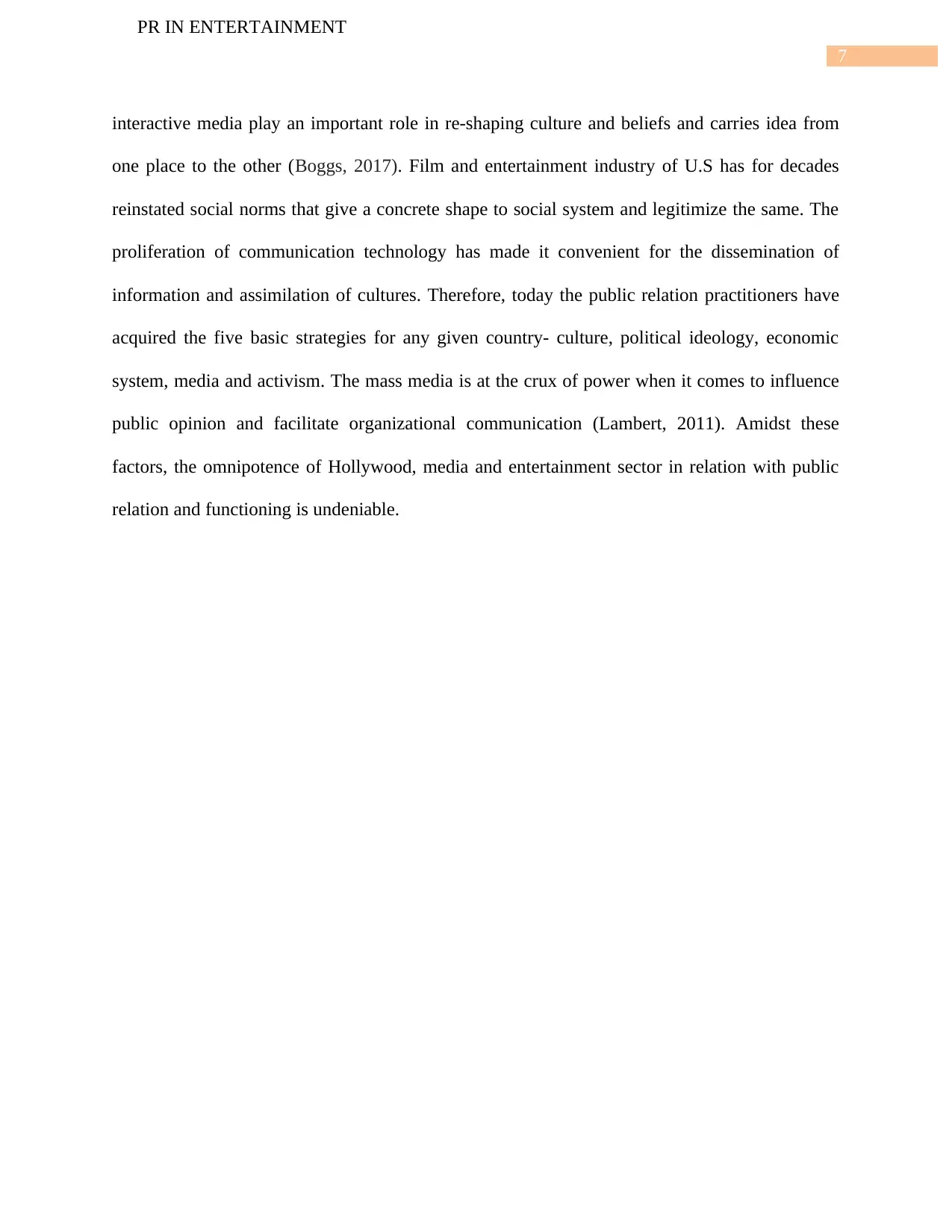
7
PR IN ENTERTAINMENT
interactive media play an important role in re-shaping culture and beliefs and carries idea from
one place to the other (Boggs, 2017). Film and entertainment industry of U.S has for decades
reinstated social norms that give a concrete shape to social system and legitimize the same. The
proliferation of communication technology has made it convenient for the dissemination of
information and assimilation of cultures. Therefore, today the public relation practitioners have
acquired the five basic strategies for any given country- culture, political ideology, economic
system, media and activism. The mass media is at the crux of power when it comes to influence
public opinion and facilitate organizational communication (Lambert, 2011). Amidst these
factors, the omnipotence of Hollywood, media and entertainment sector in relation with public
relation and functioning is undeniable.
PR IN ENTERTAINMENT
interactive media play an important role in re-shaping culture and beliefs and carries idea from
one place to the other (Boggs, 2017). Film and entertainment industry of U.S has for decades
reinstated social norms that give a concrete shape to social system and legitimize the same. The
proliferation of communication technology has made it convenient for the dissemination of
information and assimilation of cultures. Therefore, today the public relation practitioners have
acquired the five basic strategies for any given country- culture, political ideology, economic
system, media and activism. The mass media is at the crux of power when it comes to influence
public opinion and facilitate organizational communication (Lambert, 2011). Amidst these
factors, the omnipotence of Hollywood, media and entertainment sector in relation with public
relation and functioning is undeniable.
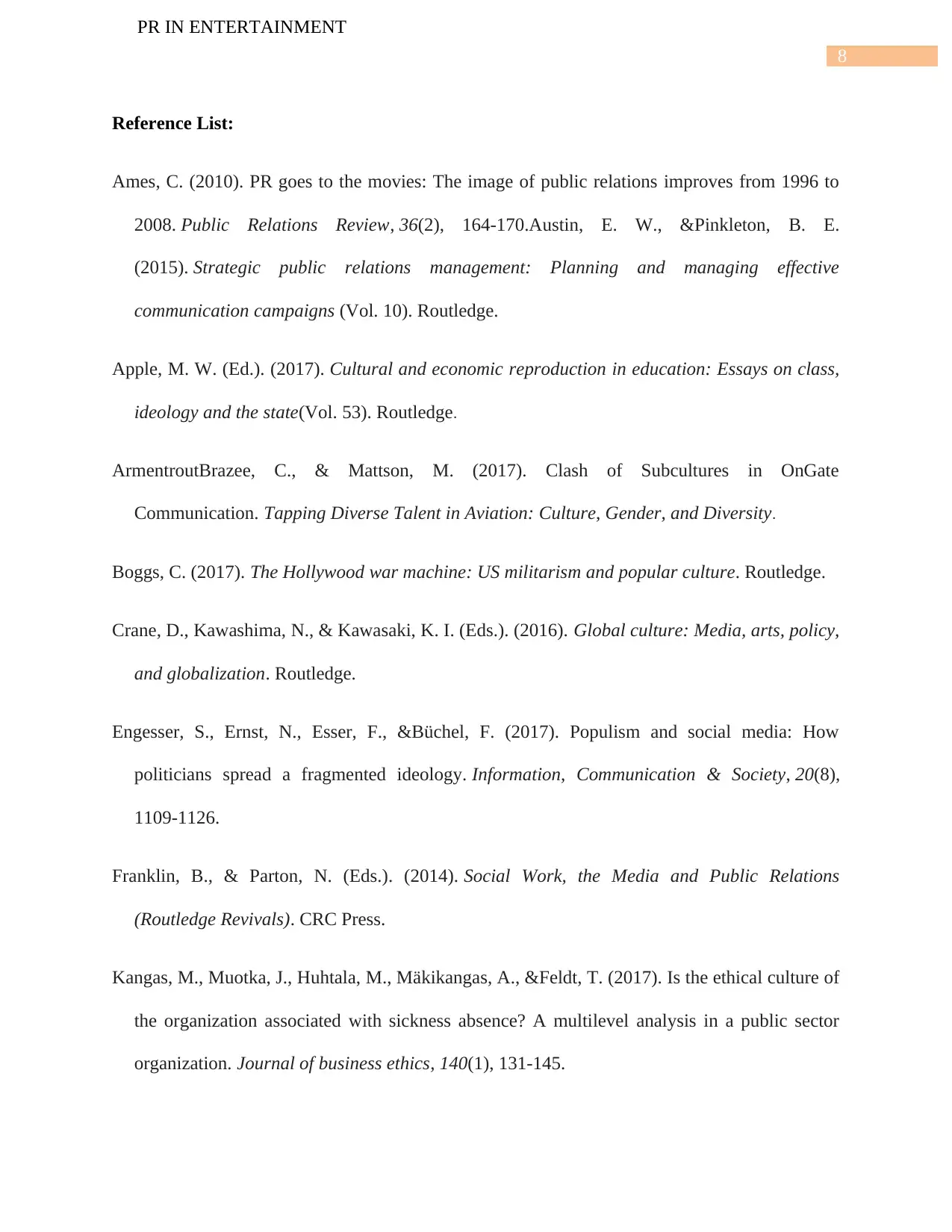
8
PR IN ENTERTAINMENT
Reference List:
Ames, C. (2010). PR goes to the movies: The image of public relations improves from 1996 to
2008. Public Relations Review, 36(2), 164-170.Austin, E. W., &Pinkleton, B. E.
(2015). Strategic public relations management: Planning and managing effective
communication campaigns (Vol. 10). Routledge.
Apple, M. W. (Ed.). (2017). Cultural and economic reproduction in education: Essays on class,
ideology and the state(Vol. 53). Routledge.
ArmentroutBrazee, C., & Mattson, M. (2017). Clash of Subcultures in OnGate
Communication. Tapping Diverse Talent in Aviation: Culture, Gender, and Diversity.
Boggs, C. (2017). The Hollywood war machine: US militarism and popular culture. Routledge.
Crane, D., Kawashima, N., & Kawasaki, K. I. (Eds.). (2016). Global culture: Media, arts, policy,
and globalization. Routledge.
Engesser, S., Ernst, N., Esser, F., &Büchel, F. (2017). Populism and social media: How
politicians spread a fragmented ideology. Information, Communication & Society, 20(8),
1109-1126.
Franklin, B., & Parton, N. (Eds.). (2014). Social Work, the Media and Public Relations
(Routledge Revivals). CRC Press.
Kangas, M., Muotka, J., Huhtala, M., Mäkikangas, A., &Feldt, T. (2017). Is the ethical culture of
the organization associated with sickness absence? A multilevel analysis in a public sector
organization. Journal of business ethics, 140(1), 131-145.
PR IN ENTERTAINMENT
Reference List:
Ames, C. (2010). PR goes to the movies: The image of public relations improves from 1996 to
2008. Public Relations Review, 36(2), 164-170.Austin, E. W., &Pinkleton, B. E.
(2015). Strategic public relations management: Planning and managing effective
communication campaigns (Vol. 10). Routledge.
Apple, M. W. (Ed.). (2017). Cultural and economic reproduction in education: Essays on class,
ideology and the state(Vol. 53). Routledge.
ArmentroutBrazee, C., & Mattson, M. (2017). Clash of Subcultures in OnGate
Communication. Tapping Diverse Talent in Aviation: Culture, Gender, and Diversity.
Boggs, C. (2017). The Hollywood war machine: US militarism and popular culture. Routledge.
Crane, D., Kawashima, N., & Kawasaki, K. I. (Eds.). (2016). Global culture: Media, arts, policy,
and globalization. Routledge.
Engesser, S., Ernst, N., Esser, F., &Büchel, F. (2017). Populism and social media: How
politicians spread a fragmented ideology. Information, Communication & Society, 20(8),
1109-1126.
Franklin, B., & Parton, N. (Eds.). (2014). Social Work, the Media and Public Relations
(Routledge Revivals). CRC Press.
Kangas, M., Muotka, J., Huhtala, M., Mäkikangas, A., &Feldt, T. (2017). Is the ethical culture of
the organization associated with sickness absence? A multilevel analysis in a public sector
organization. Journal of business ethics, 140(1), 131-145.
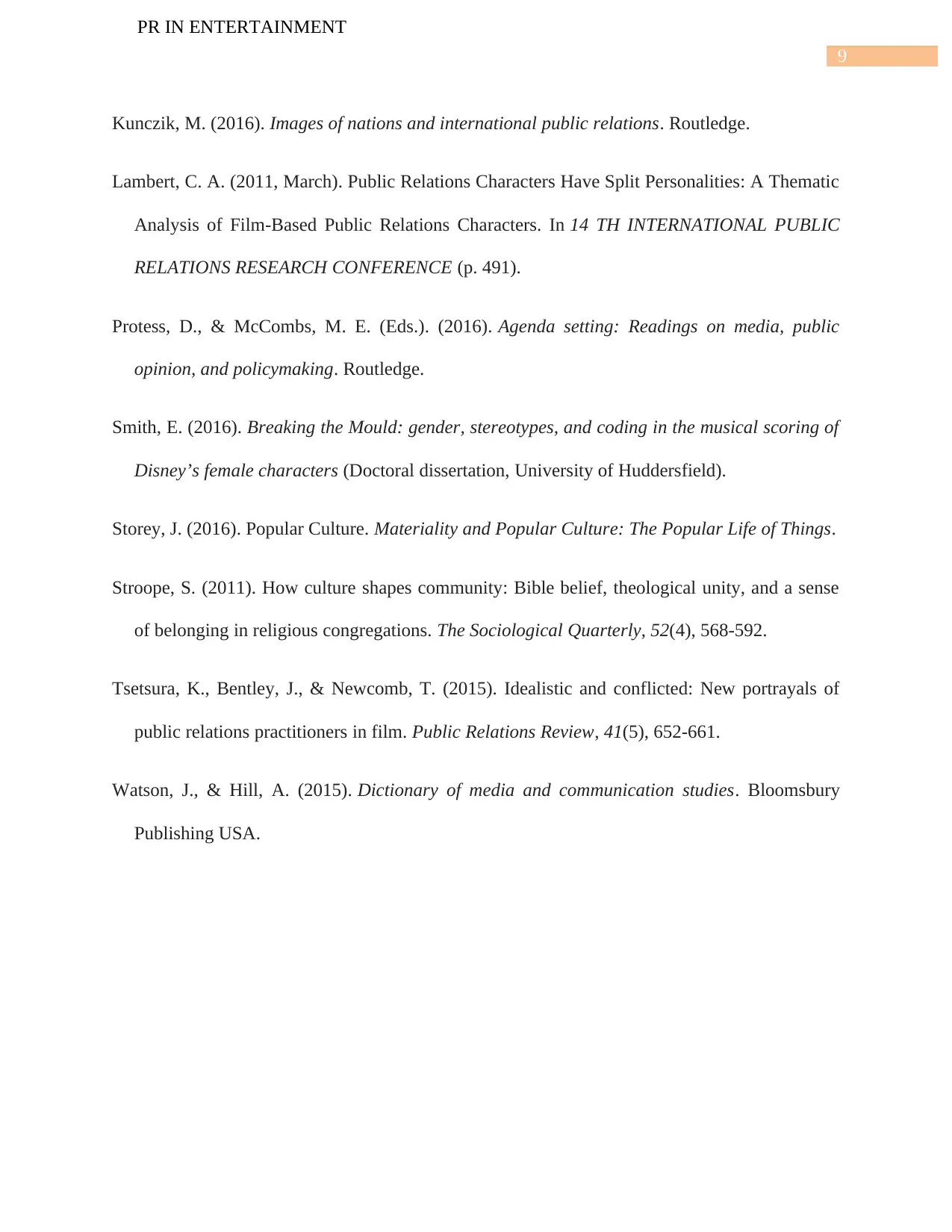
9
PR IN ENTERTAINMENT
Kunczik, M. (2016). Images of nations and international public relations. Routledge.
Lambert, C. A. (2011, March). Public Relations Characters Have Split Personalities: A Thematic
Analysis of Film-Based Public Relations Characters. In 14 TH INTERNATIONAL PUBLIC
RELATIONS RESEARCH CONFERENCE (p. 491).
Protess, D., & McCombs, M. E. (Eds.). (2016). Agenda setting: Readings on media, public
opinion, and policymaking. Routledge.
Smith, E. (2016). Breaking the Mould: gender, stereotypes, and coding in the musical scoring of
Disney’s female characters (Doctoral dissertation, University of Huddersfield).
Storey, J. (2016). Popular Culture. Materiality and Popular Culture: The Popular Life of Things.
Stroope, S. (2011). How culture shapes community: Bible belief, theological unity, and a sense
of belonging in religious congregations. The Sociological Quarterly, 52(4), 568-592.
Tsetsura, K., Bentley, J., & Newcomb, T. (2015). Idealistic and conflicted: New portrayals of
public relations practitioners in film. Public Relations Review, 41(5), 652-661.
Watson, J., & Hill, A. (2015). Dictionary of media and communication studies. Bloomsbury
Publishing USA.
PR IN ENTERTAINMENT
Kunczik, M. (2016). Images of nations and international public relations. Routledge.
Lambert, C. A. (2011, March). Public Relations Characters Have Split Personalities: A Thematic
Analysis of Film-Based Public Relations Characters. In 14 TH INTERNATIONAL PUBLIC
RELATIONS RESEARCH CONFERENCE (p. 491).
Protess, D., & McCombs, M. E. (Eds.). (2016). Agenda setting: Readings on media, public
opinion, and policymaking. Routledge.
Smith, E. (2016). Breaking the Mould: gender, stereotypes, and coding in the musical scoring of
Disney’s female characters (Doctoral dissertation, University of Huddersfield).
Storey, J. (2016). Popular Culture. Materiality and Popular Culture: The Popular Life of Things.
Stroope, S. (2011). How culture shapes community: Bible belief, theological unity, and a sense
of belonging in religious congregations. The Sociological Quarterly, 52(4), 568-592.
Tsetsura, K., Bentley, J., & Newcomb, T. (2015). Idealistic and conflicted: New portrayals of
public relations practitioners in film. Public Relations Review, 41(5), 652-661.
Watson, J., & Hill, A. (2015). Dictionary of media and communication studies. Bloomsbury
Publishing USA.
1 out of 10
![[object Object]](/_next/static/media/star-bottom.7253800d.svg)





